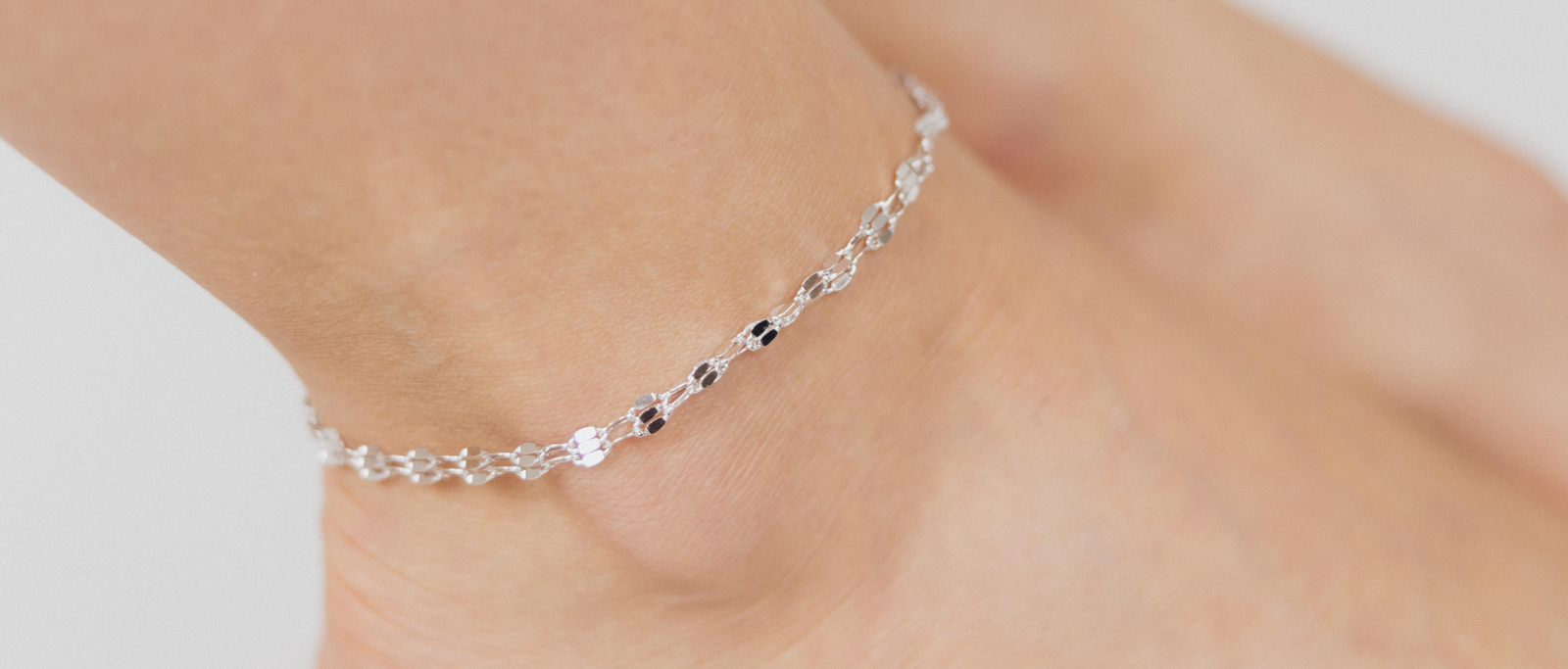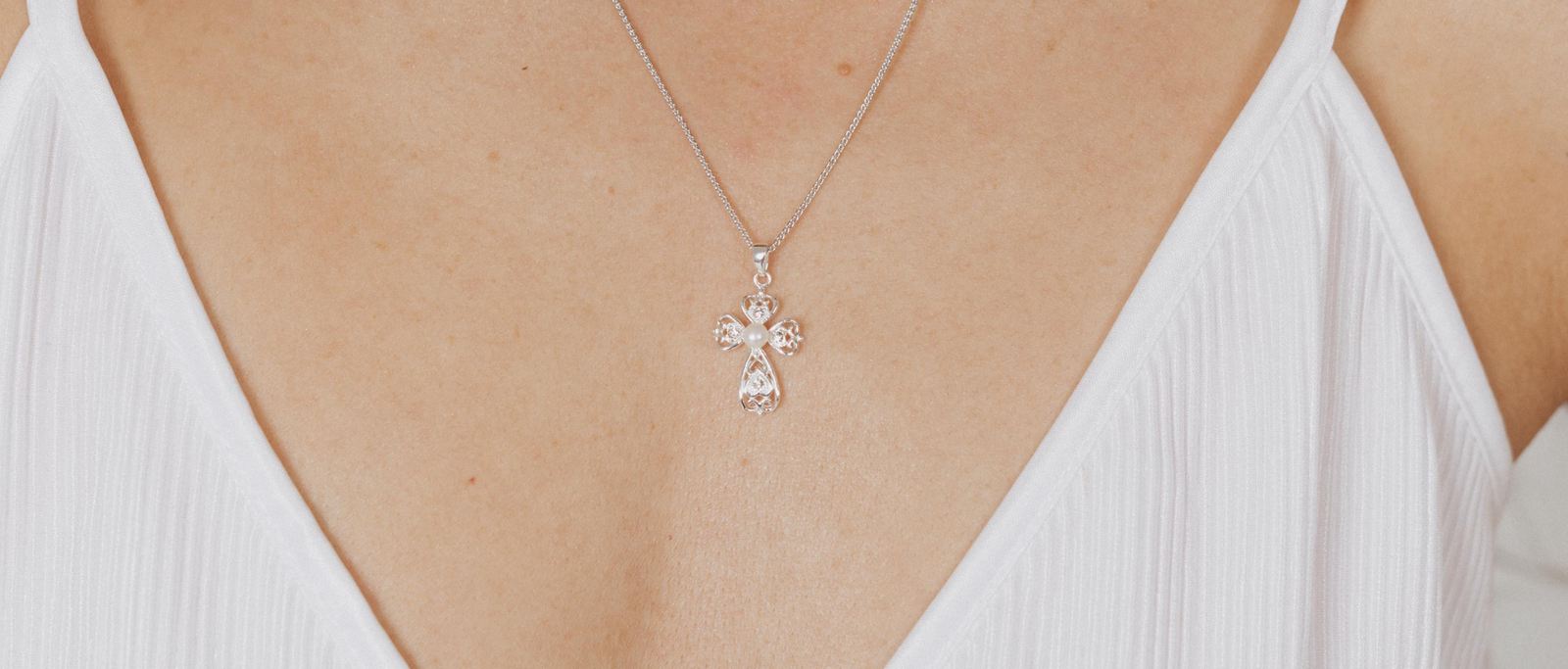Sterling Silver vs Stainless Steel Jewelry: The Differences Explained
Keyword(s): sterling silver vs stainless steel jewelry
According to a survey on women’s jewelry preferences, 35% of women favored white gold. Despite its allure, white gold can be on the pricier side, especially for those aiming to diversify their jewelry collection. Silver, gathering 17% of votes, came in second, being viewed as more versatile and cost-effective.
In the realm of silver jewelry, preferences might lean toward stainless steel for some, while others might opt for sterling silver. Although both exhibit a silver-like sheen, they are distinctly different. When comparing sterling silver vs. stainless steel jewelry, each type offers unique properties and advantages.
Want to delve deeper into the differences between sterling silver vs. stainless steel jewelry? Continue reading below.
Sterling Silver vs. Stainless Steel Jewelry-Composition

Stainless steel is a widely used metal alloy in jewelry-making, typically consisting of iron, titanium, carbon, and chromium. Its silver finish gives it a look akin to sterling silver jewelry.
Conversely, sterling silver jewelry is made up of 92.5% pure silver combined with 7.5% metal alloy, such as nickel, zinc, or copper. To bolster the soft pure silver, it is often coated with a layer of alloy, rendering it more substantial and suitable for jewelry.
Tarnish Factor

Sterling silver jewelry is susceptible to tarnishing over time, particularly if exposed to high humidity, chemicals, or direct sunlight. Improper storage when not worn can also accelerate tarnishing. However, with appropriate sterling silver care, its luster can be preserved longer.
Stainless steel jewelry, favored by some for its tarnish-resistance, owes this quality to its inner layer of chromium. Its resistance to corrosion and lack of discoloration make it ideal for active individuals, maintaining its silvery appearance with minimal upkeep.
Overall Maintenance

Maintaining sterling silver jewelry involves more effort, requiring regular cleaning and polishing to avoid tarnish. Proper storage between uses is also essential to maintain its appearance.
On the other hand, stainless steel jewelry boasts low maintenance; a simple wash with mild soap and water followed by drying with a soft towel is sufficient. This ease of care makes stainless steel a low-maintenance option.
While sterling silver jewelry isn’t necessarily high-maintenance, it does demand occasional extra care.
Hypoallergenic Properties

Hypoallergenic jewelry is designed to avoid triggering allergic reactions. When labeled as hypoallergenic, it means that the materials used should not cause allergies, such as nickel allergies.
Stainless steel is generally considered hypoallergenic due to the absence of commonly allergenic materials. Sterling silver, however, may include nickel in its alloy, potentially causing allergic reactions for some.
For those with nickel allergies, it’s advisable to seek out sterling silver jewelry that contains copper instead of nickel or ensure it is explicitly labeled as nickel-free.
Durability

Despite its alloy layer, sterling silver is inherently more delicate, prone to scratches and dents over time. Thus, it may not be the best choice for those engaging in strenuous physical activities.
With superior durability, stainless steel jewelry resists scratches and dents and retains its appearance over time. It is durable enough to be worn during physical activities without fear of damage, making it perfect for active lifestyles.
Cost

Cost-wise, stainless steel jewelry is the most budget-friendly. Sterling silver’s value fluctuates with the silver market, making it pricier.
This is subjective, as some may prefer to invest in sterling silver jewelry for its quality and potential as an heirloom, despite the higher price compared to stainless steel. However, sterling silver remains a cost-effective alternative to more expensive metals like platinum and white gold.
Weight

The metal composition of stainless steel makes it heavier, making it a preferred choice for larger, contemporary jewelry pieces. If you’re…
If you’re on the hunt for bold statement jewelry, stainless steel might be the perfect choice for you.
Compared to stainless steel, sterling silver is substantially lighter. This characteristic makes sterling silver a great option for detailed and elaborate designs, as well as for customized silver jewelry pieces.
Everyone’s preferences regarding the weight of their jewelry can differ; while some may appreciate the heft of heavier jewelry styles, others might opt for smaller, lighter pieces.
Uses in Jewelry

Stainless steel is a good match for contemporary and modern jewelry designs. It’s frequently employed in men’s jewelry and body jewelry. You can spot stainless steel in various jewelry pieces such as:
- Cufflinks
- Watches
- Earrings
- Chains
- Necklaces
- Bracelets
Sterling silver is equally versatile and finds its place in both classic and traditional jewelry designs. It can also be used to craft striking contemporary statement pieces.
Due to its delicacy, sterling silver is ideal for jewelry types like birthstone pieces, initial jewelry, anklets, toe rings, pendants, engraved jewelry, along with standard rings, bracelets, necklaces, and earrings.
Flexibility

Because stainless steel has low malleability, it’s best suited for bold and modern designs. Sterling silver, however, is highly flexible and can be fashioned into various designs using techniques like filigree, laser cutting, and enameling.
A significant distinction between sterling silver and stainless steel jewelry is their ring sizing adaptability. Sizing a stainless steel ring is challenging due to its rigidity, whereas sterling silver rings can be resized more easily thanks to their malleability.
Identifying Marks

Genuine stainless steel jewelry typically lacks specific identifying marks but may feature a Maker’s Mark to indicate its brand origin. Occasionally, you might find markings like “316L” to signify a high stainless steel grade.
One of the advantages of sterling silver is its identifying marks. You’ll often find stamps on sterling silver jewelry to verify its authenticity. Look for marks such as:
- .925
- 925
- Sterling
- Ster925 or 925Ster
- 92.5
- 925S or S925
If your sterling silver piece doesn’t have one of these marks, it might be a forgery or imitation. Additionally, sterling silver may feature Maker’s Marks and Country of Origin stamps. For instance, in the UK, a lion passant stamp indicates genuine sterling silver.
Availability

Both sterling silver and stainless steel jewelry are easily accessible through numerous online and physical jewelry retailers. Since both metals are sourced from abundant resources, there’s no need for concern about their supply running out.
The main constraint might be locating specific pieces you desire. More intricate designs may require custom creation rather than being readily available for purchase.
Appearance

The visual distinction between sterling silver and stainless steel jewelry is one of their most interesting differences. Sterling silver offers a shiny, high-end appearance with a lustrous sheen. In contrast, stainless steel provides a more metallic, silvery look with a subtler finish.
Ultimately, your choice will depend on your personal style and aesthetic preference. Either way, you have a variety of jewelry designs to choose from with both metals.
It’s not uncommon for individuals to wear both sterling silver and stainless steel together for a bold look. Mixing metals is a fantastic way to showcase a modern, eclectic style.
Find Beautiful High-Quality Sterling Silver Jewelry Today
Jewelry selection is a highly personal endeavor, reflecting individual styles and tastes. With the knowledge of the differences between sterling silver and stainless steel jewelry, you can now make an informed decision to choose the best pieces for your needs.
Artful Bracelets offers high-quality, affordable luxury bridge jewelry crafted from sterling silver. It’s the perfect way to enhance your personal brand and expand your jewelry collection.
Explore our new arrivals on our website today.
←



